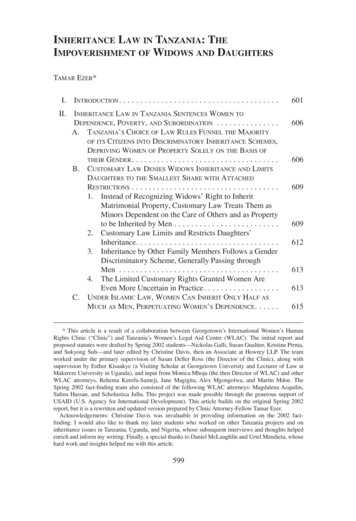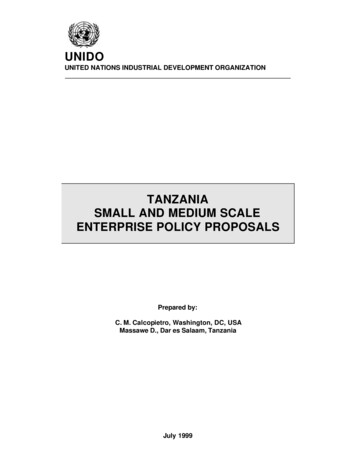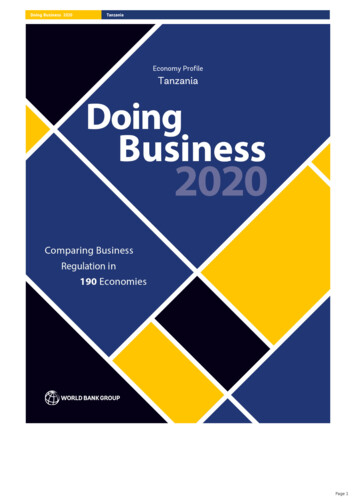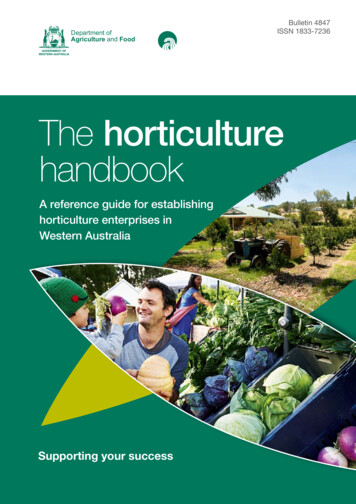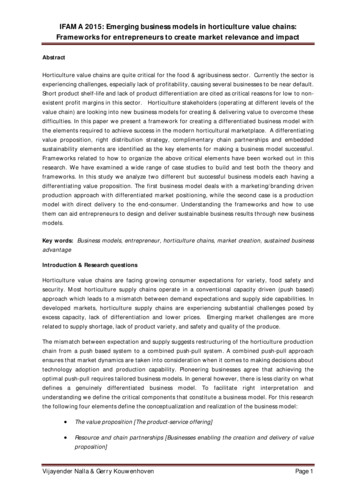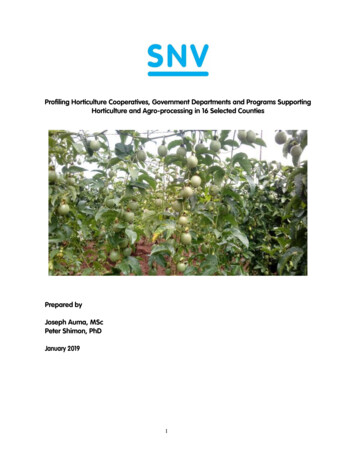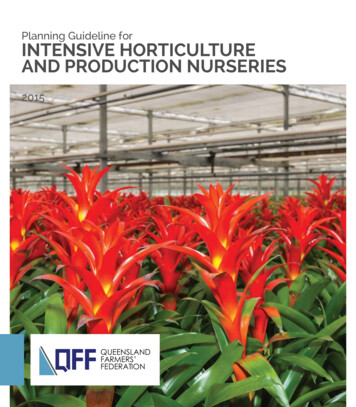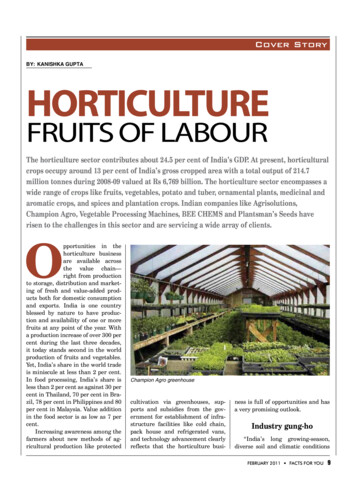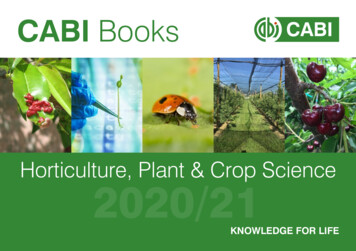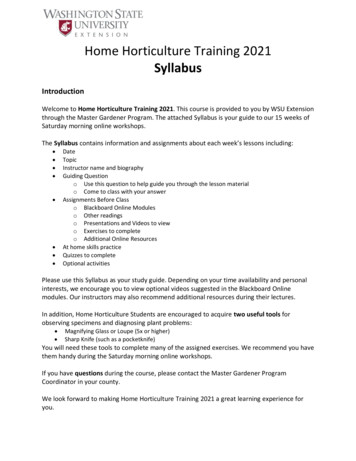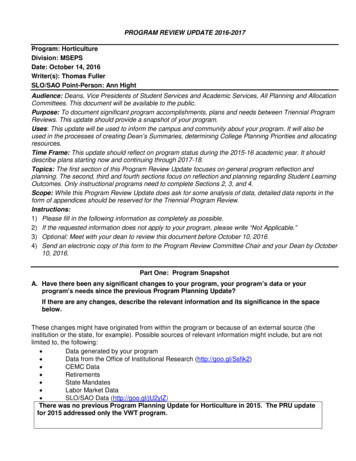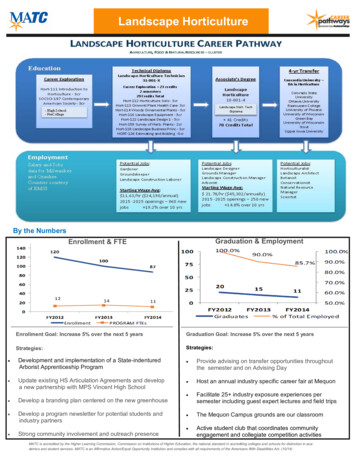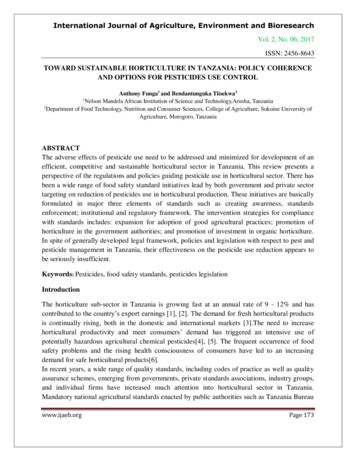
Transcription
International Journal of Agriculture, Environment and BioresearchVol. 2, No. 06; 2017ISSN: 2456-8643TOWARD SUSTAINABLE HORTICULTURE IN TANZANIA: POLICY COHERENCEAND OPTIONS FOR PESTICIDES USE CONTROLAnthony Funga1 and Bendantunguka Tiisekwa21Nelson Mandela African Institution of Science and Technology,Arusha, Tanzania2Department of Food Technology, Nutrition and Consumer Sciences, College of Agriculture, Sokoine University ofAgriculture, Morogoro, TanzaniaABSTRACTThe adverse effects of pesticide use need to be addressed and minimized for development of anefficient, competitive and sustainable horticultural sector in Tanzania. This review presents aperspective of the regulations and policies guiding pesticide use in horticultural sector. There hasbeen a wide range of food safety standard initiatives lead by both government and private sectortargeting on reduction of pesticides use in horticultural production. These initiatives are basicallyformulated in major three elements of standards such as creating awareness, standardsenforcement; institutional and regulatory framework. The intervention strategies for compliancewith standards includes: expansion for adoption of good agricultural practices; promotion ofhorticulture in the government authorities; and promotion of investment in organic horticulture.In spite of generally developed legal framework, policies and legislation with respect to pest andpesticide management in Tanzania, their effectiveness on the pesticide use reduction appears tobe seriously insufficient.Keywords: Pesticides, food safety standards, pesticides legislationIntroductionThe horticulture sub-sector in Tanzania is growing fast at an annual rate of 9 - 12% and hascontributed to the country’s export earnings [1], [2]. The demand for fresh horticultural productsis continually rising, both in the domestic and international markets [3].The need to increasehorticultural productivity and meet consumers’ demand has triggered an intensive use ofpotentially hazardous agricultural chemical pesticides[4], [5]. The frequent occurrence of foodsafety problems and the rising health consciousness of consumers have led to an increasingdemand for safe horticultural products[6].In recent years, a wide range of quality standards, including codes of practice as well as qualityassurance schemes, emerging from governments, private standards associations, industry groups,and individual firms have increased much attention into horticultural sector in Tanzania.Mandatory national agricultural standards enacted by public authorities such as Tanzania Bureauwww.ijaeb.orgPage 173
International Journal of Agriculture, Environment and BioresearchVol. 2, No. 06; 2017ISSN: 2456-8643of standards (TBS)and Tanzania Food and Drug Authority (TFDA) are enforced in thehorticultural sector to ensure food safety and protect consumer’s health. Like other developingcountries, the scope of national legislation in Tanzania is considered insufficient to ensurecompetitive export market and domestic public health[7]. As a result, many other privatestandards as institutions have emerged partly as a response to a lack of, or weak enforcement ofpublic regulation leading to the development of internationally recognized standards andregulatory schemes [8].Private standard schemes (e.gGlobalGAP, East African Organic Products Standards (EAOPS),Fair Trade Rapunzel, MPS-ABC, Unilever Sustainable Agriculture Code, BRC Global Standardfor Food Safety issue, MPS-Socially Qualified (SQ), IFOAM Standard) are gaining importancein the Tanzania horticultural sector. Furthermore, horticultural producers and exporters have tocomply with stringent sanitary and phyto-sanitary (SPS) and maximum residue limits (MRL)standards as well as hazard analysis and critical control points (HACCP) and GlobalGAPstandards. In this article, different reports and studies are reviewed to provide an overview ofcurrent or past legislation, policy, strategies and programs aimed at improving pesticidemanagement in the horticultural sector in Tanzania.Regulations and policies supporting pesticides management in horticulture sectorRegulationsAs a member of the world trade organization (WTO), Tanzania is required to comply with theinternational standards within the WTO framework. Tanzania became a member of theInternational Plant Protection Convention (IPPC) in 2005 and has since then worked through theplant health services (PHS) to ensure compliance to the IPPC standards. Phytosanitary measuresincluding all relevant laws, decrees, regulations, requirements and procedures are taken by thegovernment in order to protect plant health. The Tanzania plant protection Act No. 13 (1997)provides a legal framework for plant protection in prevention and spread of harmful organisms,control of importation and use of pesticides, regulation of export and imports of pesticides andensures fulfilment of international commitments. The Tanzania Environmental Management Actof 2004 entail various regulations pertaining to persistent organic pollutants (POP) and pesticidesissues, to ensure that they are in compliance with the Stockholm convention on POP of 2001 andthe Rotterdam convention on the prior informed consent procedure for certain hazardouschemicals and pesticides in international trade.Institutional set upThe management of food safety and agriculture standards in horticultural sector in Tanzania isdone by a number of institutions each with a different matter to address on standards. Thesewww.ijaeb.orgPage 174
International Journal of Agriculture, Environment and BioresearchVol. 2, No. 06; 2017ISSN: 2456-8643usually range from SPS to quality matters, regulations, capacity building and compliance by thehorticultural producers and processors themselves. The management of SPS in Tanzania is themandate of the ministry of agriculture through its plant health services (PHS) unit which alsoacts as the national plant protection organization.The TBS conducts the implementation ofstandards through certification schemes; inspection and testing; and quality management systemregistration (ISO 9000). The bureau is also the national enquiry point (NEP) on SPS andtechnical barriers to trade (TBT) agreements of the WTO. The PHS is responsible for themanagement of pest outbreaks, promotion of integrated pest management and other training,awareness building and surveillance activities related to plant health. While TBS is moreconcerned with standardization and quality matters, TFDA mandate focus on food safety andprotection of consumer’s health. The tropical pesticides research institute (TPRI) is responsiblefor monitoring, registration of new chemical pesticides, inspection of pesticides retail shops,capacity building on different aspects of pesticide trade and safe use.PoliciesThe policy governing horticultural development falls under the national agricultural sectoralpolicies which promotes production of quality products. In the policy statement, horticulturalcommodity standards are promoted and regulated to meet national and international marketrequirements[9].Furthermore, at the national level, the principal agricultural developmentpolicies and programs favour integrated pest management (IPM) as recommended approach topest management as needed option for compliant with GAP and ensure export standards.However, the national agriculture policy does not specifically entail IPM issues, but mentionsthat pest management options need to be compliant with GAP to ensure export standards, whichis a critical requirement in international trade. The agricultural sector development programme(ASDP-2) is the current development and programme promoting increased sustainableagricultural production in Tanzania. Most relevant for pest and pesticide management iscomponent 2 of ASDP-2 which aims to enhance agricultural productivity and profitability.National initiativesA number of initiatives have been implemented by public and private organizations to bringstrong compliance with food safety standards targeting on reduction of pesticides use inhorticultural production. A Global GAP national technical working group has been formulated tocoordinate horticultural standards development and work with farmers to meet internationalstandards [10]. The government of Tanzania and FAO in partnership with the horticulturalindustry has devoted coercive efforts to create awareness on good agricultural practices (GAP) inhorticultural production. Furthermore, the USAID-TAPP have developed clusters of commercialsmall scale horticultural farms in Arusha, Kilimanjaro, Lushoto, Morogoro, the Coastal strip, andZanzibar as a platform to facilitate GAP adoption. As highlighted in the report of standards andwww.ijaeb.orgPage 175
International Journal of Agriculture, Environment and BioresearchVol. 2, No. 06; 2017ISSN: 2456-8643trade development facility in East Africa [11], efforts have been made for SPS capacity buildingfrom a. continuation of donor support for specific project initiatives (Table 1).Table 1: SPS-related initiatives in TanzaniaAgencyInitiativePlant ProtectionNetherlands (WSSD)/TAHA:Development of pesticides manual and generalpublicity campaign; Development of industry-driventraining program for export horticulture; Improvingphytosanitary system for horticulture exports;Pesticide registration arrangementsFAOTCP project on training , surveillance and legislation,2008USAIDAir-freight Program (TAP) for horticulture;Integration of small scale farmers into value chains;PASA projects, 2006-2011STDFCreation of Eastern Africa Centre of PhytosanitaryExcellenceEstablishment of pest risk analysis (PRA) unitFood safetyFAO/DANIDA/Switzerland/UNIDO Improving TBSaccreditationlaboratoryinfrastructureandSeveral donor (basket) programsSchemes for upgrading food safety and quality insmall and medium enterprises (SMEs) throughtraining, loans, partial subsidiesEUCapacity Building on Maximum Residue Levels(MRLs) (2006-2010); Support for Standards, QualityAssurance, Accreditation and Metrology (SQAM)2006-2011;USAID/USDAwww.ijaeb.orgPage 176
International Journal of Agriculture, Environment and BioresearchVol. 2, No. 06; 2017ISSN: 2456-8643Strengthening food safety systems through sanitaryand phytosanitary (SPS) measures (ACP, 2008 –2012); PASA projects focusing on food safety (20062011)Horticultural sectorNetherlands (WSSD) / TAHATraining for horticultural industry workers ; Supportfor pesticide registrationUNDP (IF Window II )SPS training for horticulture industryFAO/ Norway/ UNEstablishment ofsurveillance systemEDFCapacity building for companies and farmers on foodsafety issues/SPS (2008-2013phytosanitarycontroland[WSSD, World Summit on Sustainable Development; TAHA Tanzania Horticulture Association,STDF, Standards and Trade Development Facility Trust Fund; PASA, Participating AgencyService Agreement; FAO Food and Agriculture Organisation; DANIDA, Danish InternationalDevelopment Agency; UNIDO United Nations Industrial Development Organisation, UNDP,United Nations Development Programme; USAID, United States Agency for InternationalDevelopment; USDA, United States Department of Agriculture, EDF, European DevelopmentFund]National horticultural development strategy 2012- 2021The strategy envisages facilitating the development of horticultural industry so as to improvenutritional status, increase incomes and reduce poverty while increasing productivity and qualityof the produce [12]. Expansion of the production base and quality improvement is one of themain pillars of the strategy. As shown in Table .2 several horticultural development programshave been implemented for improving the quality and compliance with standards. These includeexpansion for adoption of GAPs and required standards; promotion of horticulture in thegovernment authorities; strengthening of training institutions; and promotion of investment inorganic horticulture [13]. In an effort to promote the application and adherence to quality andsafety standards at farm and market, the TBS implemented a project (2012-2014) through thelocal capacity building of farmers and consultants; training in GlobalGAPs; development ofquality management system (QMS) for fruits and vegetables; and preparation of quality andstandards for fruits and vegetables.www.ijaeb.orgPage 177
International Journal of Agriculture, Environment and BioresearchVol. 2, No. 06; 2017ISSN: 2456-8643Key issues in pesticide regulation and managementAlthough progress has been made in some areas of pesticide regulation in horticultural sector,the overall level of SPS and quality management remains weak. The current efforts in complyingwith the international requirements for market access is clearly inadequate in terms of technicalcapacity of regulatory authorities, competence, resource allocation and poor institutional clarity.Effort to comply with pesticides related standards is further affected by limited awareness andlow priority given to plant health issues. This is viewed in terms of limited awareness amongfarmers and private sector of plant health issues, good agricultural practice, and safe use ofpesticides. Limited research activities in the area of pesticides reduction in horticulturalproduction is another key factors for slow adoption of standards. Numerous laboratories are inplace with limited ability to undertake pesticides analyses. Although some progress has beenmade in upgrading SPS laboratory capacity with accreditation of TBS laboratories the overalldiagnostic capacity is still weak.Table 2: Food safety intervention program in horticultural sectorStrategic InterventionsStrategic ActivitiesResponsibleOrganisationEquip extension officers with the latest MOA,Industrialtechnicalinformationforkey associationshorticulture crops on Good AgriculturalPractices (GAP) and existing standardsConduct horticulture crop production MOA,HODECT,practice and post – harvest care PORALG, Industryworkshops and training sessions for associationsgrowersanddistrictagricultureextension agentsConduct training on the requirements for TAHA, MITM,Expand adoption of Global GAP certification and how toPrivate sectorGoodAgricultural obtain certificationPractices (GAP) andEstablish the National Technical TAHA, MITMrequired standardsWorking Group to investigate theviability of supporting local certificationwww.ijaeb.orgPage 178
International Journal of Agriculture, Environment and BioresearchVol. 2, No. 06; 2017ISSN: 2456-8643capabilitiesEncourage extension officers and other Industry associations,regulators to promote the application ofquality and safety standards along the MOA, TBS, TFDAvalue chainStrengthen public extension services and MOA,PORALG,encourage private sector participation in Private sector,offering extension services.Industry associationsPromote Horticulture in Promote the application and adherence TBSthe Governmentto quality and safety standards at farmand marketPromote investment in Support development of organic and fair Private sector,organic horticulturetrade labelled products; Promote localcertification to reduce involved cost; Industry associations,Establish farmer blocks to reduce MITMcertification cost[MOA, Ministry of Agriculture; PORALG,President Office Regional Administrative andLocal Government; MITM,Ministry of Industry, Trade and Marketing; TBS, TanzaniaBureau of Standards; TFDA Tanzania Food and Drug Authority; HODECT,HorticulturalDevelopment Council of Tanzania]The limited awareness and understanding of the risks of pesticides, as well as limited expertise todevelop and enforce legislation results into poor pesticides handling and risk assessment. As aresult, farmers apply pesticides without prior checking for pest infestations, mixtures ofpesticides, pesticides without personal protective equipment, and lack of handling procedures forempty containers [14]. There exist important deficiencies in legislation, registration, andenforcement of pesticides in Tanzania [15]. Pesticide registration system is underdeveloped andlack published guidelines of pesticide requirements, and the necessary registration requirementssuch as the requirement to reregister a pesticide periodically. As a result, retailers distributeunauthorized pesticides, which had not been registered in Tanzania [16]. The small scale farmersin Tanzania lack appropriate knowledge on safe handling and use of pesticides [17].www.ijaeb.orgPage 179
International Journal of Agriculture, Environment and BioresearchVol. 2, No. 06; 2017ISSN: 2456-8643Monitoring programs and official inspection of horticultural produces to ensure compliance withMRLs is not often done in Tanzania, the case that may provide uncertainty on chemical safety offresh fruits and vegetables. Furthermore, data of pesticides residue contamination horticulturalproduces in monitoring programs by legislative bodies such TFDA, TPRI and ministry ofagriculture are relatively few and largely qualitative. The national safety standard for mostcommon horticultural produces is not currently being implemented in Tanzania. Rarely is a clearregulatory requirement for risk assessment of mixtures of pesticides within a national regulatoryframework. Current pesticides regulations in Tanzania do not adequately allow for greater thanadditive toxicity to address mixtures of pesticides with a similar mechanism of action and do notaddress chemical synergism and the effects of mixtures of pesticides from multiple classes.Recommendations for Policy InterventionWhile some initiatives has been done toward adoptions of standards, the following keyrecommendations are made for its success: strengthening of enforcement mechanisms to promotesafe pesticides use and handling practices need to be addressed through review of relevantpolicies and legislation; critical assessment of regulatory and institutional capacity in terms oftheir strengths and weaknesses to establish a system that covers small scale producers. In order tobe effective, standards need a favorable economic and institutional environment to which publicpolicies and initiatives should contribute. Due to the presence of many competing initiatives andthe lack of a coordinating actor, there is a need for organization that combines public policieswith the merits of private intervention. Furthermore, there is a need to strengthen delivery ofpublic information, education and awareness programs as well as monitoring of adverse effectsto human health and the environment caused by pesticides use.ConclusionA number of measures have been taken to stimulate adoption of food and agricultural standards,to reduce pesticide use and ensure inclusive growth of the horticultural sector in Tanzania. Theseinclude legal and regulatory change; institutional organization; policy and strategies; technicaland scientific researches investments in physical infrastructure and strengthening of accreditationand certification systems. The core aspects of initiatives are basically formulated in major threeareas of creating awareness, capacity building and institutional and regulatory framework.Although the necessary basic framework for SPS management in horticultural sector is in place,little progress has been made to ensure competitiveness of the sector. There is a need for reviewof relevant policies and legislation focusing on reduction of pesticide use.www.ijaeb.orgPage 180
International Journal of Agriculture, Environment and BioresearchVol. 2, No. 06; 2017ISSN: 2456-8643References1. Match marker associates,“Horticulture Study:Mapping of production of fruits andvegetables in Tanzania,” Final wsector%202017.pdf2. K. Mwakanemela,“Challenges Facing Agricultural Sector in Accessing Credit fromFinancial Institutions The Case Study of Horticulture Subsector in Tanzania,” InternationalJournal of Emerging Trends in Science and Technology, 1(05), 2014.3. G.Malorgio,A. Felice, “Trade and logistics: the fruit and vegetables industry,” InMediTERRA 2014 (english) (pp. 149-171),2014. Presses de Sciences Po (PFNSP).4. S. Williamson, A. Ball, J. Pretty, “Trends in pesticide use and drivers for safer pestmanagement in four African countries,” Crop protection, 27(10): 1327-1334, 2008.5. H.De Bon, J.Huat, L.Parrot, A.Sinzogan, T. Martin, E. Malézieux, J. F Vayssières,.“Pesticide risks from fruit and vegetable pest management by small farmers in sub-SaharanAfrica,” A review. Agronomy for sustainable development, 34(4), 723-736,2014.6. R.Wongprawmas, M.Canavari, C. Waisarayutt, “A multi-stakeholder perspective on theadoption of good agricultural practices in the Thai fresh produce industry,” British FoodJournal, 117(9): 2234-2249,2015.7. M. Hatanaka, C. Bain,L. Busch, “Third-party certification in the global agrifoodsystem,“Food policy, 30(3); 354-369,2005.8. M.Gebreeyesus, “Firm adoption of international standards: evidence from the Ethiopianfloriculture sector,” Agricultural economics, 46(S1): 139-155, 2015.9. MAFC,“National Agriculture Policy 2013. Ministry of Agriculture, Food Security andCooperatives Government of Tanzania,” 2013.10. TAHA,“Horticulture Value Chain In /arusha/Tanzania TAHA.pdf Accessed in 24th September 201511. M Abegaz, “Mobilizing aid for trade for SPS-related technical cooperation in East Africa,”Report of research work for the Standards and Trade Development Facility, 28-29, 2008.12. HODECT,“Tanzania horticultural development strategy 2012–2021,”201013. HODECT,“Horticultural Development Program,” Draft, 201114. J.Senyagwa,L.Persson, “How far to the 2020 goal?: the Strategic Approach to InternationalChemicals Management in Tanzania,”Stockholm Environment Institute,2014.15. WHO,“Guidelines on public health pesticide management policy for the WHO t/iris/bitstream/10665/97939/1/9789241501231 eng.pdfwww.ijaeb.orgPage 181
International Journal of Agriculture, Environment and BioresearchVol. 2, No. 06; 2017ISSN: 2456-864316. E. E.Lekei, A. V.Ngowi,L.London, “Farmers' knowledge, practices and injuries associatedwith pesticide exposure in rural farming villages in Tanzania,” BMC public health, 14(1):389,2014.17. A. V. F Ngowi, T. J.Mbise, A. S. MIjani, L. London,O. C Ajayi,“Pesticides use bysmallholder farmers in vegetable production in Northern Tanzania,” Crop Protection(Guildford, Surrey), 26(11): 1617,2007.www.ijaeb.orgPage 182
Fair Trade Rapunzel, MPS-ABC, Unilever Sustainable Agriculture Code, BRC Global Standard for Food Safety issue, MPS-Socially Qualified (SQ), IFOAM Standard) are gaining importance in the Tanzania horticultural sector. F
